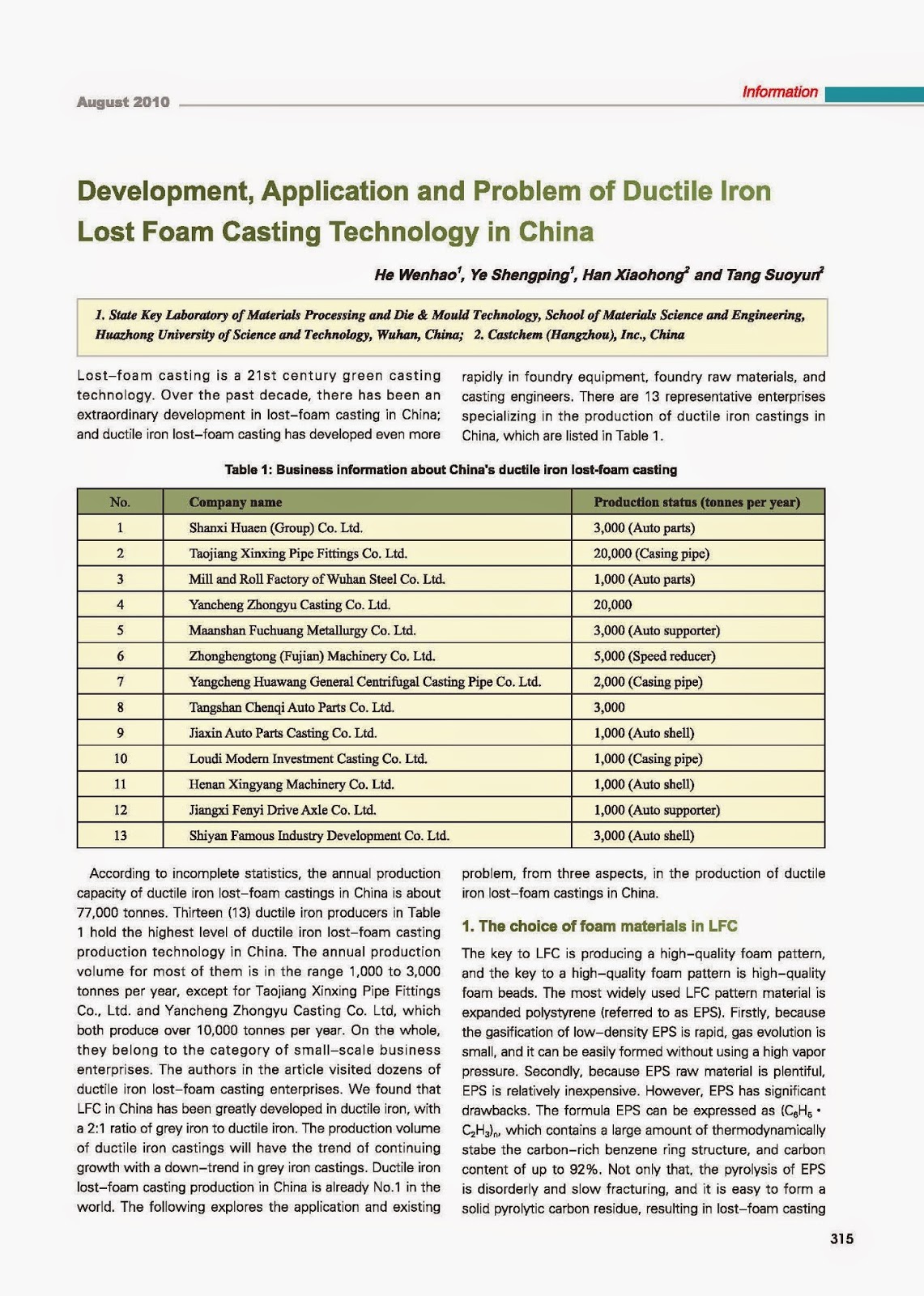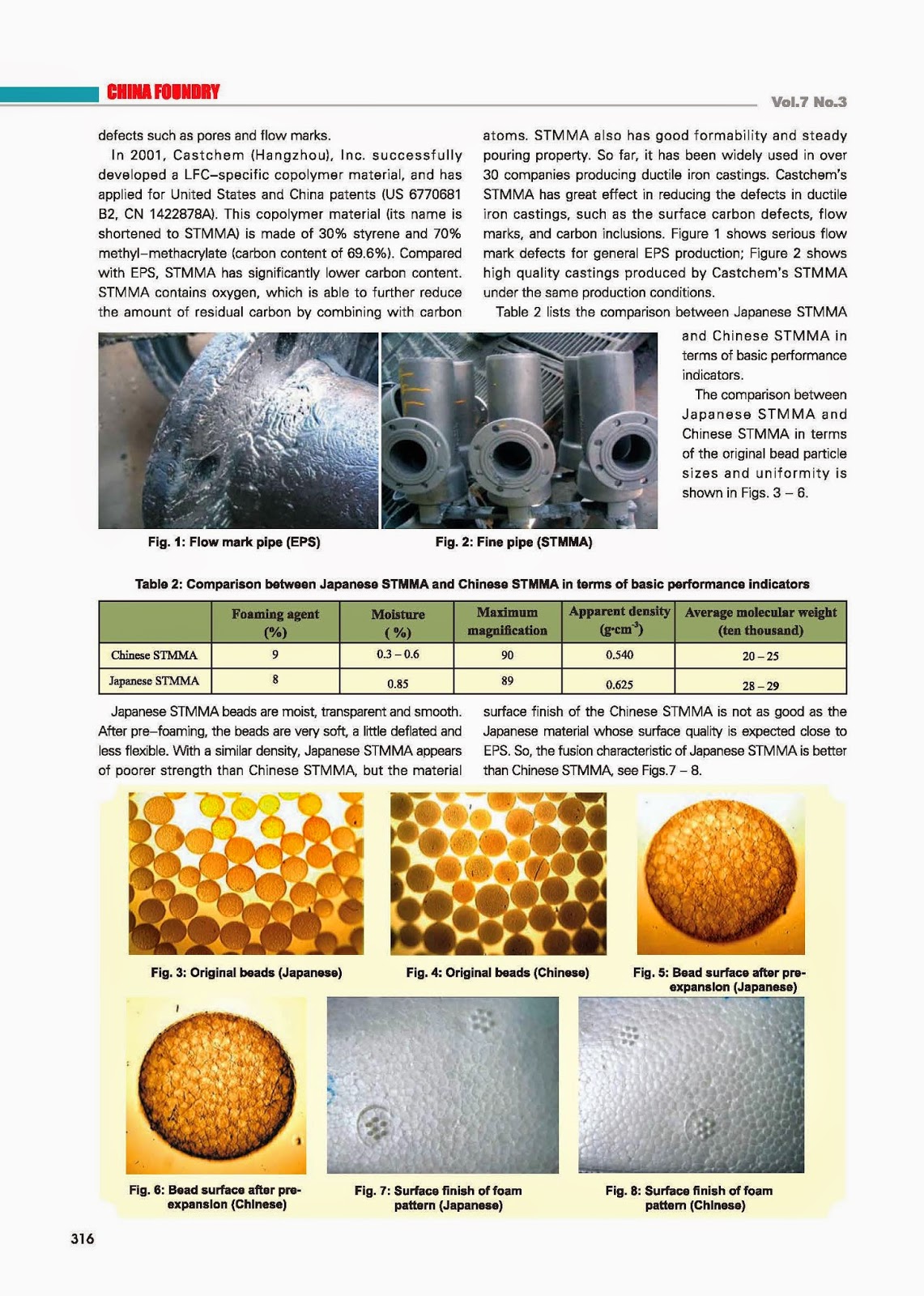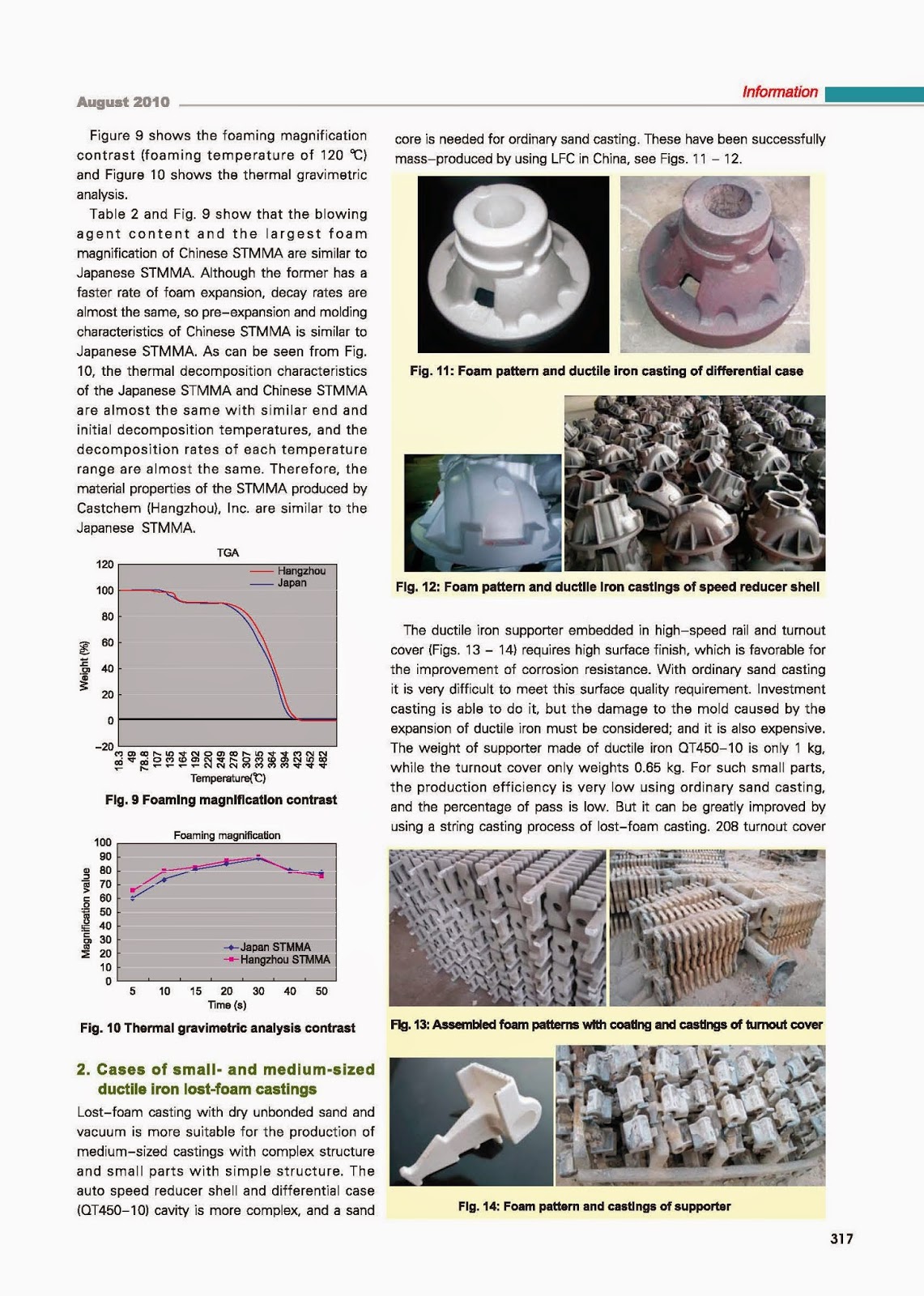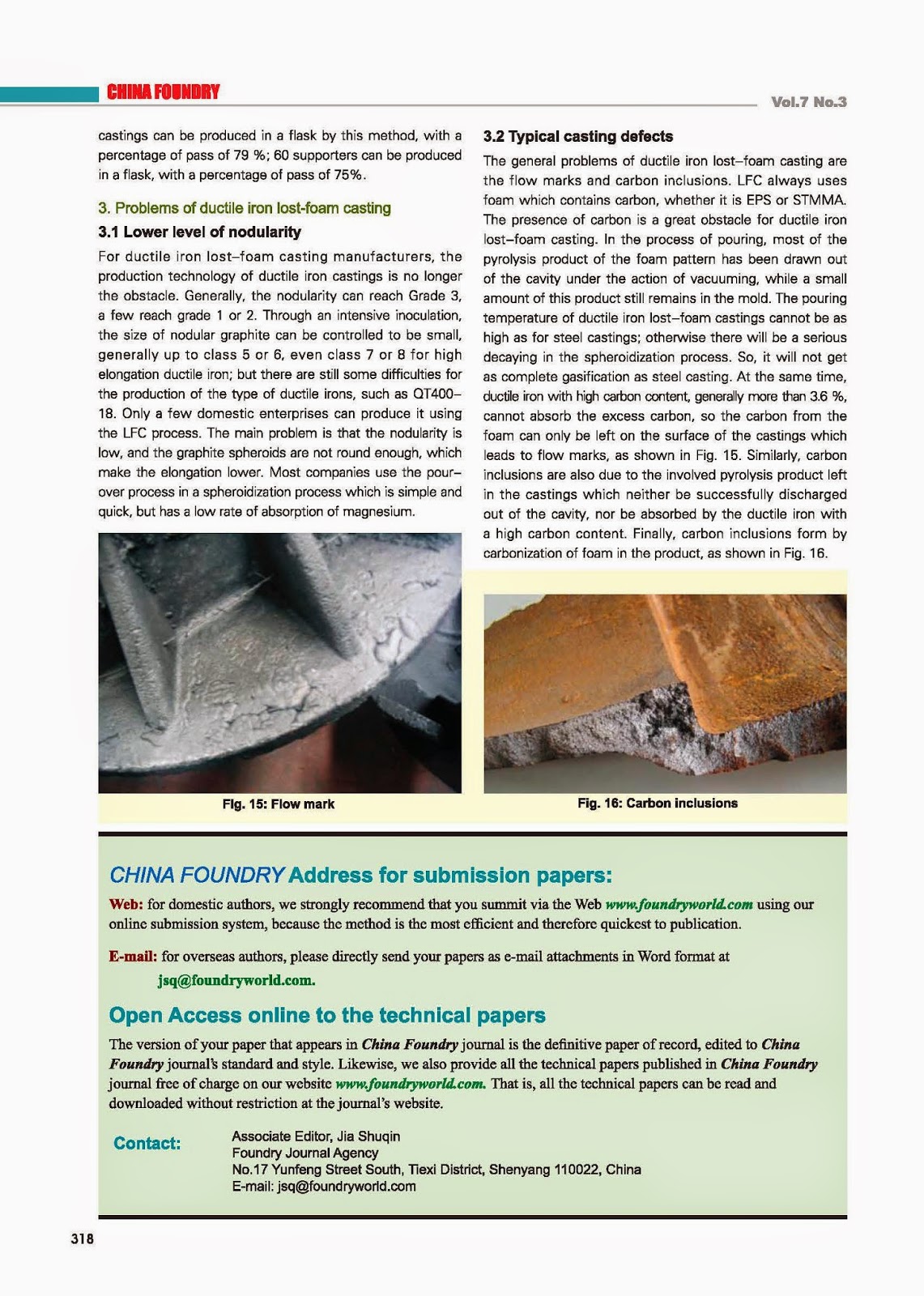foamcast lost foam metal casting technology
foamcast is a hybrid of the Lost Foam Casting process, an innovative foam pattern molding and metal casting process.
Tuesday, January 13, 2015
Friday, July 4, 2014
Can Chinese Lost Foam Technology bring business to Indian Foundry?
Sixty-two percent of metal casting shipments in the world are made in China. Total metal casting shipments in China now are estimated at 32 million tons, which is 36% of the total world tonnage. Following are the factors driving the growth of the Chinese metal casting industry:
- Most metal casters pour multiple alloys;
- Quality control is weak;
- Environmental protection laws are not completely enforced;
- Productivity is relatively poor because of labor intensive cleaning of castings;
- Raw materials are plentiful;
- Coke is inferior but cheap
Many Indian foundries have had to compete with China and have lost the battle due to these factors that are really China specific. Apart from these factors, of late EPC – Expendable Pattern Casting or V-LFC – Vacuum Lost Foam Casting commonly known as lost foam has been a popular and upcoming foundry process in China. Although the Chinese foundry industry has implemented LFC extensively they really have not focused on the quality of the castings as much as they have concentrated on delivering volumes, resulting in inferior casting quality and castings which have earned the name “China-Like” castings.
So how does India compete with China? Everybody – especially the West – is addicted to how cheap China is. To understand the gravity of this situation one has to understand:
- When it comes to quality castings India is preferred over China and
- Chinese castings are cheaper than Indian castings not just because of the foundry process
Naturally the sections in the Indian foundry industry directly affected by the “China-Like” casting threat have arrived at a conclusion that the lost foam process is the process that gives China the edge and the key to competing with the Chinese Foundry Industry. Although the Lost Foam Process is the key foundry process that does make the difference the question really is whether adopting the Lost Foam Process offered by Chinese equipment manufacturer in totality the way ahead?
Before this question is addressed we have to first understand whether casting buyers from the west will accept “China-Like” casting quality from Indian foundry? It is a fact that a casting buyer from the West is prepared to buy substandard casting from China because of the tempting prices but when it comes to buying from India he expects quality castings but at the same prices offered by China. What options does Indian foundry have? Chinese lost foam or the indigenous developed foamcast®?
In this situation the logical approach would be to do what the Chinese are doing and if it is lost foam then let us adopt the process from China itself since it works there fine. Is this the right approach?
There are about half a dozen consultants and engineering companies in China that offer Turn-key Lost Foam Casting solutions. The only qualification these companies and consultants have is that their process is implemented at a Chinese foundry and that they can arrange a visit to that foundry. During such visits the process is displayed from a distance and there is no exchange of technical views either intentionally or due to the language handicap.
Now coming back to the question whether casting buyers from the west will accept “China-Like” casting quality from Indian foundry?
Let’s assume that the Lost Foam Castings manufactured in China are inferior. Typical inferiorities found in Chinese LFC parts are foam inclusions and lustrous carbon inclusions, which make the castings weak and porous especially if they have to be machined.
In this case if an Indian foundry employs the same lost foam process offered by the same Chinese equipment manufacturer that makes the inferior castings they would end up manufacturing inferior China-like castings in India too. Furthermore if the Chinese lost foam equipment manufacturer’s benchmark for quality is the inferior castings manufactured in China then there is no way the manufacturer can promise and deliver casting quality better than what is available in China.
Similarly let’s say that the LFC Castings manufactured in China are of good benchmark quality.
Therefore if an Indian foundry employs the same lost foam process offered by the same Chinese equipment manufacturer that makes the good benchmark quality castings they would be manufacturing similar good quality China-like castings in India too.
But here is the difference, regardless of casting quality good or bad, the lost foam process offered by the same Chinese equipment manufacturer that has supplied his equipment to a successful Chinese Lost Foam foundry heavily depends on raw materials and coatings manufactured in China which are not available in India. The success of Chinese LFC foundries hinges on availability of
- STMMA which is used for molding the foam patterns and is not manufactured in India and
- The refractory coating or as the Chinese call it “paint” required for Chinese lost foam is also not manufactured in India.
Both the “paint” and STMMA are byproducts of materials manufactured in bulk in China hence they are cost effective. These base products have not been developed in India hence developing a cost effective byproduct is not a viable proposition.
This brings us to square one that is; will an Indian Lost Foam foundry which employs a lost foam process offered by a Chinese equipment manufacturer be able to compete with a Chinese foundry? The answer is NO it cannot.
If Indian foundry has to import all critical raw materials and coatings from China, Indian foundry logically cannot compete with China. These materials are naturally more cost effective if purchased and consumed within China.
So does this mean Indian foundry cannot employ the lost foam process? The answer to this is the indigenous developed foamcast® process which utilizes materials that are available and are manufactured in India.
Unlike the Chinese Lost Foam Process which cannot be used for Stainless Steel, foamcast® is suitable for all ferrous and non-ferrous materials including Stainless Steel. Briefly here is why foamcast® is better:
- All materials used by foamcast are abundantly available in India
- Materials are cheaper hence the process cost is cheap
- Know-how for foamcast is indigenous
- There is no language barrier which is essential for interacting during technology transfer
Indian foundry should not shift focus from delivering quality castings just to compete with China. Good quality castings can be manufactured at Chinese prices by adopting the foamcast® process.
Sunday, September 22, 2013
Difference between foamcast and lost foam casting process offered in China
During our efforts to promote foamcast - lost foam metal casting technology, of late many foundries have asked us one common question - "How is foamcast different from the lost foam process in use in China?"
Most Lost Foam Casting foundries in China project that lost foam cannot and should not be used to manufacture steel castings. Lost foam foundries in China & Europe have experienced that, with the exception of certain heat-resistant alloys, carbon pick-up from the polystyrene foam patterns during pouring contaminates most steel grades, producing regions within a casting where the mechanical properties are extremely inferior. This problem is commonly known as "lustrous carbon" in the lost foam casting industry.
To compensate for the "lustrous carbon" defect the Chinese use and recommend EPS-PMMA a material that is designed to leave low carbon residue. The problem is EPS-PMMA is four times more expansive than the EPS used in the foamcast Process. EPS-PMMA is not manufactured in India and has to be imported with a minimum order quantity of 17.0 Tons. (1no. Full Container as EPS is termed as hazardous material and part shipment is banned) EPS-PMMA has a shelf life of 6 months if stored in a moisture free environment at 20.0 degrees C. Due to this limitation and with a foam to metal ration of 1:150 you have pour 2550 Tons of castings within six months so that the imported EPS-PMMA is used within its expiry date.
Most Chinese foundries recommend the metal to be over heated by approx. 200 degrees over the required temperature so that the metal does not loose its fluidity while it is burning the foam. In areas where the metal has lost it fluidity foam inclusion in the casting takes place which is exposed post machining or under pressure testing.
The foamcast Process is alien to all these problems associated with the traditional lost foam process since in the foamcast process we build up a ceramic shell on the polystyrene foam pattern. On firing the ceramic, all traces of the polystyrene foam are removed before the mould is buried in the supporting un-bonded silica sand.
The foamcast process is very much similar to the Lost Wax process but with certain key differentiating characteristics. For example, polystyrene foam is lighter, stronger and insensitive to temperature. Polystyrene foam patterns can be produced in very thin or thick walls (2-200mm). Complex shapes can be formed by gluing sections thus allowing design freedom of the Lost Foam process. The physical properties of polystyrene foam enable thinner ceramic shells as compared to lost wax. Due to the use of thinner shells in the foamcast Process pre-heating the ceramic mould before pouring it not NOT required.
In addition to the above process advantages, on the shop floor level too the foamcast Process is simpler to operate. The foam pattern molding process is done on a vertically moving molding machine. This enables use of bigger molding tools with complex manually operated cores. The Chinese are familiar with horizontally moving machines that limit the size of the molding tools and require very expensive auto core removal devices. The design of the foamcast pattern molding machine allows the use of four different molding tools at any given time which allows us to mold any number of patterns from just a few to thousands. The Chinese molding machine does not allow this flexibility.
Thus, the foamcast® process enables castings of a size commonly associated with sand moulding to be manufactured in a way that achieves the as-cast integrity, surface finish and dimensional accuracy associated with the Lost Wax process. And this has been achieved at lower cost, especially in end-product manufacturing cost, compared with traditional sand castings.
For more information about foamcast process please visit www.foamcast.in
Tuesday, May 31, 2011
Advantages of foamcast metal casting process over traditional sand casting.
I am pleased to share with you the following information about the foamcast process:
Advantages of foamcast over traditional sand casting:
For more information about foamcast please visit www.foamcast.in
Advantages of foamcast over traditional sand casting:
- Can be used for precision castings of ferrous and non-ferrous metals of any size.
- Fewer steps are involved in foamcast casting compared to sand casting.
- Core making is eliminated.
- Binders or other additives and related mixing processes are eliminated.
- High dimensional accuracy can be achieved and thin sections can be cast (i.e. 3 mm).
- There is lower capital investment.
- The flasks used are less expensive and easier to use because they are in one piece.
- The need for skilled labor is reduced.
- Multiple castings can be combined in one mold to increase pouring efficiency.
- Consistent casting quality
- Lower operating costs can be achieved for appropriate castings. Complex castings, particularly internal sections, which require high dimensional accuracy and have thin sections, can be produced very cost effectively in comparison with to conventional sand molding processes.
- Fettling and machining is minimized due to high dimensional accuracy and the absence of parting lines or core fins.
- The shakeout process is simplified and does not require the heavy machinery required for bonded sand systems.
- High levels of sand reuse are possible. As little as 1-2% of the sand is lost as a result of spills. Periodically a portion of sand may need to be removed or reclaimed to avoid the build-up of styrene.
For more information about foamcast please visit www.foamcast.in
Subscribe to:
Posts (Atom)



